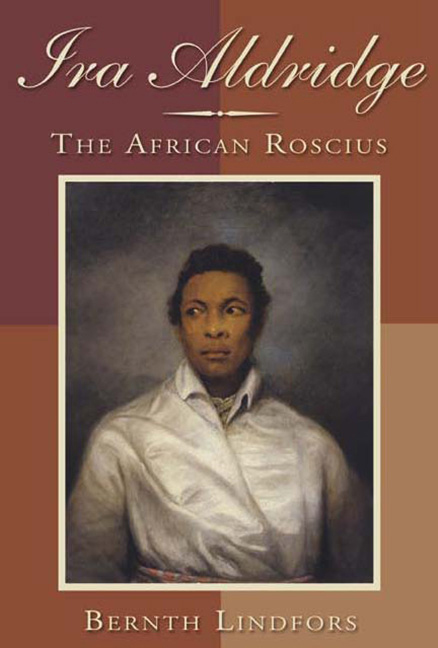Book contents
- Frontmatter
- Miscellaneous Frontmatter
- Contents
- List of Illustrations
- Acknowledgments
- Introduction
- Part One: The Life
- 1 Memoir and Theatrical Career of Ira Aldridge, the African Roscius
- 2 Ira Aldridge (1860)
- 3 Men We Have Known: Ira Aldridge (1867)
- 4 “Nothing extenuate, nor set down aught in malice”: 50 New Biographical Information on Ira Aldridge
- 5 Ira Aldridge's Swedish Wife
- 6 “African Tragedian” in Golden Prague: Some Unpublished Correspondence
- 7 A Garland of Love Letters
- Part Two: The Career
- Notes on Contributors
- Index
- Miscellaneous Endmatter
4 - “Nothing extenuate, nor set down aught in malice”: 50 New Biographical Information on Ira Aldridge
from Part One: The Life
Published online by Cambridge University Press: 26 October 2017
- Frontmatter
- Miscellaneous Frontmatter
- Contents
- List of Illustrations
- Acknowledgments
- Introduction
- Part One: The Life
- 1 Memoir and Theatrical Career of Ira Aldridge, the African Roscius
- 2 Ira Aldridge (1860)
- 3 Men We Have Known: Ira Aldridge (1867)
- 4 “Nothing extenuate, nor set down aught in malice”: 50 New Biographical Information on Ira Aldridge
- 5 Ira Aldridge's Swedish Wife
- 6 “African Tragedian” in Golden Prague: Some Unpublished Correspondence
- 7 A Garland of Love Letters
- Part Two: The Career
- Notes on Contributors
- Index
- Miscellaneous Endmatter
Summary
The remarkable life of Ira Aldridge has been faithfully reconstructed in Herbert Marshall and Mildred Stock's fine biography Ira Aldridge: The Negro Tragedian (1958). Using materials gathered from libraries and archives in Western and Eastern Europe and the United States, Marshall and Stock were able to put together a detailed documentary record of Aldridge's forty-three years on the stage, correcting many of the erroneous accounts that had been published during his lifetime and after his death in 1867. They also succeeded in uncovering new information about his personal life by interviewing his only surviving child, Amanda Ira Aldridge, then in her late eighties, who very generously gave them access to unpublished family papers. It is unlikely that such a full account of Aldridge's life and career ever would have seen print without the fortuitous collaboration of these three individuals half a century ago.
But though their research was thorough and painstaking, Marshall and Stock were well aware that they had not been able to tell the whole story. In a prologue to their biography, they admitted that “there still remained some missing links” and that the tale “was not complete in all its aspects” yet they were ready to place it before the public in the hope that, despite its “many limitations,” their book would “stimulate others to pick up where they le[ft] off, until this great man is given his rightful place in theatrical history, and until the fascinating story of a unique representative of the Negro people becomes known to the world.”1 It is in this spirit of adding a few fresh discoveries to the archive of data they recovered and assembled that the following facts are put on record.
But first, for those who may be unacquainted with America's earliest important black actor, let us briefly review what is generally known of Ira Aldridge's life and career. Marshall and Stock succeeded in establishing that he was born in New York City on July, 24 1807, and that he attended the African Free School No. 2 at Mulberry Street in lower Manhattan some time between 1820 and 1824. His father—a straw vendor and lay preacher—had wanted him to enter the religious profession, but the young Aldridge, after taking part in a few amateur dramatic productions put on by small black theater companies, aspired to become a professional actor.
- Type
- Chapter
- Information
- Ira AldridgeThe African Roscius, pp. 50 - 67Publisher: Boydell & BrewerPrint publication year: 2007

